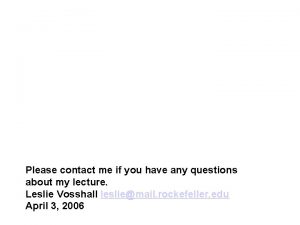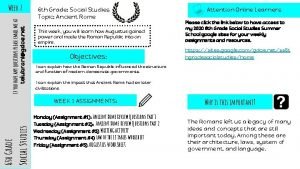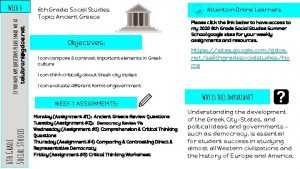If you have any questions please email me











- Slides: 11

If you have any questions please email me at telubrani@gdoe. net Week 5 6 th Grade: Social Studies Topic: Ancient Rome This week you will read about the location and founding of Rome, its early rule by kings, and the creation of the city's republican government. Please click the link below to have access to my 2020 6 th Grade Social Studies Summer School google sites for your weekly assignments and resources. Objectives: I can describe how geographic factors affected life in Ancient rome. I can describe the Roman Republic https: //sites. google. com/gdoe. net/ss 6 thgra desocialstudies/home I can identify key events in the legendary history of the founding and growth of Rome. I can compare and contrast roman societies social classes. . 6 th Grade Social Studies Attention Online Learners WEEK 1 ASSIGNMENTS: Monday (Assignment #1): Ancient Rome Review Questions Part 1 Tuesday (Assignment #2): Ancient Rome Review Questions Part 2 Wednesday (Assignment #3) PATRICIANS VS. PLEBIANS GRAPHIC ORGANIZER Thursday (Assignment #4) ROME KEY EVENTS WORKSHEET Friday (Assignment #5) Journal Reflection Why is this important? The Romans left us a legacy of many ideas and concepts that are still important today. Among these are their architecture, laws, system of government, and language.

Geography & The Rise of Rome THE GEOGRAPHY OF ITALY Rome eventually became the center of one of the greatest civilizations of the ancient world. In fact, the people of Rome conquered many of the territories you have studied in this book, including Greece, Egypt, and Asia Minor. Italy, where Rome was built, is a peninsula in southern Europe. If you look at the map, you can see that Italy looks like a highheeled boot sticking out into the Mediterranean Sea. AENEAS The Romans believed their history could be traced back to a great Trojan hero named Aeneas (i-NEE-uhs). When the Greeks destroyed Troy in the Trojan War, Aeneas fled with his followers. After a long and dangerous journey, he reached Italy. The story of this trip is told in the Aeneid (i. NEEid), an epic poem written by a poet named Virgil (VUHR-juhl) around 20 BC. According to the story, when Aeneas reached Italy, he found several groups of people living there. He formed an alliance with one of these groups, a people called the Latins. Together they fought the other people of Italy. After defeating these opponents, Aeneas married the daughter of the Latin king. Aeneas, his son, and their descendants became prominent rulers in Italy ROME’S LEGENDARY ORIGINS Rome's early history is wrapped in mystery. No written records exist, and we have little evidence of the city's earliest days. All we have found are ancient ruins that suggest people lived in the area of Rome as early as the 800 s BC. However, we know very little about how they lived. Would it surprise you to think that the ancient Romans were as curious about their early history as we are today? Rome's leaders wanted their city to have a glorious past that would make the Roman people proud. Imagining that glorious past, they told legends, or stories, about great heroes and kings who built the city. CLIMATE Most of Italy, including the area around Rome, has warm, dry summers and mild, rainy winters. This climate is similar to that of southern California. Italy's mild climate allows people to grow a wide variety of crops. Grains, citrus fruits, grapes, and olives all grow well there. A plentiful food supply was one key factor in Rome's early growth. read through this information to complete this weeks ROME RESOURCES PG. 1 6 th grade social studies Week 5

The government the Romans created in 509 BC was a republic. In a republic, people elect] leaders to govern them. Each year the Romans elected officials to rule the city. These officials had many powers but only stayed in power for one year. This system was supposed to keep any one person from becoming too powerful in the government. But Rome was not a democracy. The city's ele ted officials nearly all came from a small group of wealthy and powerful men. These wealthy and powerful Romans held all the power, and other people had little to no say in how the republic was run. According to ancient historians, Romulus was the first king of Rome, taking the throne in 7 53 BC. Modern historians believe that Rome could have been founded within 50 years before or after that date. Roman records list seven kings who ruled the city. Not all of them were Roman. Rome's last three kings were Etruscans (i-1 RUHS-kuhnz), members of a people who lived north of Rome. The Etruscans, who had been influenced by Greek colonies in Italy, lived in Italy before Rome was founded. The Etruscan kings made great contributions to Roman society. They built huge temples and Rome's first sewer. Many historians think that the Romans learned their alphabet and numbers from the Etruscans. The last Roman king was said to have been a cruel man who had many people killed, including his own advisors. Finally, a group of nobles rose up against him. According to tradition, he was overthrown in 509 BC. The nobles, who no longer wanted kings, created a new government. CHALLENGES FROM OUTSIDE Shortly after the Romans created the republic, they found themselves at war. For about SO years the Romans were at war with other peoples of the region. For the most part the Romans won these wars. But they lost several battles, and the wars destroyed many lives and much property. During particularly difficult wars, the Romans chose dictators-rulers with almost absolute power -to lead the city. To keep them from abusing their power, dictators could only stay in power for six months. When that time was over, the dictator gave up his power. One of Rome's famous dictators was Cincinnatus (sin-suh-NAT-uhs), who gained power in 458 BC. Although he was a farmer, the Romans chose him to defend the city against a powerful enemy that had defeated a large Roman army. Cincinnatus quickly defeated the city's enemies. Immediately, he resigned as dictator and returned to his farm, long before his six-month term had run out. The victory by Cincinnatus did not end Rome's troubles. Rome continued to fight its neighbors on and off for many years. 6 th Grade Social Studies week 5 ROME RESOURCES PG. 2 THE EARLY REPUBLIC Week 5 Among the descendants of Aeneas were the founders of Rome. According to Roman legends, these founders were twin brothers named Romulus (RAHM-yuh-luhs) and Remus (REE-muhs). In the story, these boys led exciting lives. When they were babies, they were put in a basket and thrown into the Tiber River. They didn't drown, though, because a wolf rescued them. The wolf cared for the boys for many years. Eventually, a shepherd found the boys and adopted them. After they grew up, Romulus and Remus decided to build a city to mark the spot where the wolf had rescued them. While they were planning the city, Remus mocked one of his brother's ideas. In a fit of anger, Romulus killed Remus. He then built the city and named it Rome after himself. Read through this information to complete this weeks assignments. ROME’S EARLY KINGS ROMULUS & REMUS

PHYSICAL FEATURES Look at the map again to find Italy's two major mountain ranges. In the north are the Alps, Europe's highest mountains. Another range, the Apennines (A-puhnynz), runs the length of the Italian Peninsula. This rugged land made it hard for ancient people to cross from one side of the peninsula to the other. In addition, some of Italy's mountains, such as Mount Vesuvius, are volcanic. Their eruptions could devastate Roman towns. Not much of Italy is flat. Most of the land that isn't mountainous is covered with hills. Throughout history, people have built cities on these hills for defense. As a result, many of the ancient cities of Italy including Rome -sat atop hills. Rome was built on seven hills. Several rivers flow out of Italy's mountains. Because these rivers were a source of fresh water, people also built their cities near them. For example, Rome lies on the Tiber (TY -buhr) River. ROME RESOURCES PG. 3 6 th Grade Social Studies Week 5 Read through this information to complete this weeks assignments.

6 th Grade Social Studies Week 5 CHALLENGES WITHIN ROME Enemy armies weren't the only challenge facing Rome. Within the city, Roman society was divided into two groups. Many of Rome's plebeians (pli-BEE-uhnz), or common people, were calling for changes in the government. They wanted more of a say in how the city was run. Rome was run by powerful nobles called patricians (puh-TRI-shuhnz). Only patricians could be elected to office, so they held all political power. The plebeians were peasants, craftspeople, traders, and other workers. Some of these plebeians, especially traders, were as rich as patricians. Even though the plebeians outnumbered the patricians, they couldn't take part in the government. In 494 BC the plebeians formed a council and elected their own officials, an act that frightened many patricians. They feared that Rome would fall apart if the two groups couldn't cooperate. The patricians decided that it was time to change the government. Read through this information to complete this weeks assignments. Roman Society Patricians Plebians Wealthy, powerful citizens Common people Nobles Peasants, crafts people, traders and other workers Small minority of the population Majority of the population Once controlled all aspects of government Gained the right to participate in government After 218 B. C. , not allowed Only Romans who could be to participate in trade or traders, so many became commerce wealthy ROME RESOURCES PG. 4

ASSIGNMENT # 1 How do you think Rome's location on the Mediterranean affected its history as it began to grow into a world power? 6 th Grade Social Studies 1. How did mountains affect life in Italy? 1. Where is Italy located? Week 5 Directions: Read through the “Ancient Rome Resources page 1 -4” then answer the following questions. Ancient Rome Review Questions Part 1

6 th Grade Social Studies ASSIGNMENT # 2 3. What type of government did the Romans create in 509 BC? 2. What role did Aeneas play in the founding of Rome? 1. What brothers supposedly founded the city of Rome? Directions: Read through the “Ancient Rome Resources page 1 -4” then answer the following questions. Ancient Rome Review Questions part 2 Week 5

Week 5 PATRICIANS VS. PLEBIANS GRAPHIC ORGANIZER Patricians Plebians 6 th Grade Social Studies What do they have in common? DIRECTIONS: USE THE GRAPHIC ORGANIZER BELOW TO COMPARE & CONTRAST How patricians and plebeians ASSIGNMENT # 3

Read pages 1 -4 of your “rome resources”then Complete the diagram below. identify the key events in the legendary history of the founding and growth of Rome. ROME KEY EVENTS WORKSHEET 6 th Grade Social studies Week 5 ASSIGNMENT # 4

Day 5: FRi. DAY Journal Reflection Assignment #5 Answer the following question to complete this assignment. Write your responses in the box on the right. 1. you have read about several legends the Romans told about their own history. Look back at the “rome Resources” to get some ideas about what you might include in your own legend. Write some ideas in your Journal. All journal entries should be written in complete sentences. Each answer should be 2 -3 sentences long. Optional: You may choose to email me your Journal entry at telubrani@gdoe. net. 6 th Grade Social Studies Week 5 Write your journal entry in this space.

Works Cited: Ancient Civilizations (World History). Holt, Rinehart & Winston, 2006. ISBN 0 -03 -073459 -2, 978 -0 -03 -073459 -5
 Feromona
Feromona If you have any questions please feel free to interrupt me
If you have any questions please feel free to interrupt me Any question thank you
Any question thank you Raymond carver will you please be quiet please
Raymond carver will you please be quiet please Any question atau any questions
Any question atau any questions They have not rejected you but me
They have not rejected you but me Have any questions
Have any questions Useful phrases for business emails
Useful phrases for business emails Possessive s quiz
Possessive s quiz Do you have any apples
Do you have any apples As-tu un animal in english
As-tu un animal in english Have you done any
Have you done any



















